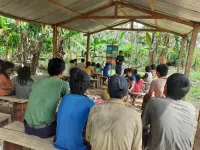(Press-News.org) When UCLA shifted to remote instruction during the early days of COVID-19, the campus was much less populated — but it wasn’t totally empty. Several species of animals continued to go about their daily lives, just with far fewer disturbances from humans.
Among them were around 300 dark-eyed juncos, a bird species that has thrived at UCLA for probably around 20 years.
A group of UCLA scientists who have been studying fear and aggression in urban juncos for years recognized that the dramatic shift in human activity presented a unique opportunity for an experiment: How would juncos adapt once campus life returned to normal?
Led by Eleanor Diamant, who was then a UCLA doctoral student, the researchers decided to find out. Specifically, they wondered, given the yearlong break from any human interaction, would juncos act more fearful once they encountered large groups of people again?
Their findings completely defied their expectations.
In a study published in Proceedings of the Royal Society B, the scientists report that, once campus life returned to normal, the birds acted “drastically less fearful” of humans. The researchers had speculated before the experiment that once juncos lost their familiarity with people, they would adopt behaviors more like their wilder cousins — who don’t typically let people get closer than about 11 1/2 feet before flying away. But that was decidedly not the case.
To judge birds’ fear levels, the scientists measured how close a person could get to the birds before they flew away. The researchers conducted the tests throughout the campus closure and again in 2022, after the campus had fully reopened. And they compared their findings with data that UCLA scientists had collected prior to the pandemic, in 2018 and 2019.
Before the closure, juncos allowed researchers to get within about 65 inches, on average, before they flew away. That figure remained consistent for the duration of the closure. But in 2022, when campus life had mostly returned to normal, juncos allowed people to get even closer — an average of just 39 inches — before they fled. The study also found that during the period of time when people were mostly absent, the birds demonstrated little change in how close they allowed humans to get.
Interestingly, there was no statistically significant difference in the behaviors of birds that hatched during the closure and those who had interacted with people before the pandemic began. (Researchers identified the juncos with individualized bands around their legs, a standard practice for studying birds.)
Juncos provided a particularly interesting case study because they feed and nest mostly on the ground, where close encounters with humans are common. Before the pandemic, UCLA’s juncos had become accustomed to the commotion of a large urban university; prior research showed that the juncos living in urban regions of Southern California were significantly less fearful of people than juncos in non-urban areas.
Biologists have two main theories about how wild birds get used to living around people in densely populated environments. The first holds that birds that encounter large numbers of humans become less fearful over time, a process called habituation. That theory also suggests that birds that live without much human interaction either will become more fearful of people or that their fear response will not change over time.
The other theory holds that birds living in cities are there in part because they innately have less fear of humans in the first place.
But Diamant said the study’s findings didn’t line up with either of those theories.
“What we found doesn’t match either of them,” she said. “If less fearful birds had chosen to live on campus in the first place, we would have expected their fear response to be essentially unchanged. If they were habituated, we would have thought they’d become more fearful during the closure and then less fearful after, or not shift their behavior at all.
“But these birds didn’t shift fear response with humans absent and they shifted toward much less fearful after humans came back.”
To collect the data, researchers received permission from UCLA administrators to venture onto campus in 2020 and 2021, during the COVID-19 closure.
Pamela Yeh, a UCLA professor of ecology and evolutionary biology, and the study’s senior author, said the findings could be explained in one of two ways. First, she said, it may be that once animals’ fear response gets tamped down, new events will tamp it down further. Or it could be that the fear response, after being lowered, tends to return to its normal level, Yeh said.
Further study of UCLA’s junco population should help determine which option explains the findings.
“The effects of humans on wild animals are really complex and what we expect isn’t always what we get,” Yeh said. “So our research shows both the complexity of the juncos’ response to humans and of their response to other changes.”
The study also may offer a glimmer of hope for North American birds, whose population has diminished dramatically — due in large part to human disturbances in their natural habitats. By some estimates, there are nearly 3 billion fewer adult birds in North America alone than there were in 1970, including about 175 million fewer dark-eyed juncos.
“For me, the takeaway is that there’s so much complex animal behavior that we don’t know about, even though they are our neighbors in cities,” said Diamant, who is now a postdoctoral scholar at Ben Gurion University of the Negev in Israel. “There are these surprising reactions animals have to collective human behavior. We might not know what they are because we can’t test for them, but only these kinds of massive and unexpected events like the pandemic bring them into focus.”
END
Birds living at UCLA were less afraid of humans after the pandemic closure
After a year with little human interaction, dark-eyed juncos were surprisingly more comfortable with people once campus life returned to normal
2023-08-23
ELSE PRESS RELEASES FROM THIS DATE:
Guiding the design of silicon devices with improved efficiency
2023-08-23
Silicon is one of the most pervasive functional materials of the modern age, underpinning semiconductor technologies ranging from microelectronics to solar cells. Indeed, silicon transistors enable computing applications from cell phones to supercomputers, while silicon photovoltaics are the most widely deployed solar-cell technology to date. The U.S. Department of Energy (DOE) reports that nearly 50% of new electric generation capacity in 2022 came from solar cells, and according to the International Energy Agency (IEA), silicon has a 95% market share. Yet despite silicon’s ...
NREL analysis quantifies impacts of setback ordinances on land available for renewable energy deployment
2023-08-23
The number of local zoning ordinances governing renewable energy deployment is growing in the United States, according to new research by the U.S. Department of Energy’s National Renewable Energy Laboratory (NREL). The amount of land available to deploy renewables depends on the characteristics of the ordinances.
“It’s important to understand the types of ordinances in effect, specifically setback ordinances, or the required distance from a specific feature like a house,” said Anthony ...
BU research probes the contradictory roles of SAA in fighting inflammation and infection while triggering life-threatening disease
2023-08-22
(Boston) – Serum amyloid A (SAA) is a family of ancient proteins that can be traced from present-day humans back half a billion years to sea cucumbers and oysters. A new study by researchers from the Boston University Chobanian & Avedisian School of Medicine explores the link between the dual nature of this small plasma protein: how it works to clear toxic debris from wounds and inflammation sites, but also its role in forming fibrous deposits of the pathologic amyloid in vital organs such as the ...
AI can predict certain forms of esophageal and stomach cancer
2023-08-22
In the United States and other western countries, a form of esophageal and stomach cancer has risen dramatically over the last five decades. Rates of esophageal adenocarcinoma, or EAC, and gastric cardia adenocarcinoma, or GCA, are both highly fatal.
However, Joel Rubenstein, M.D., M.S., a research scientist at the Lieutenant Colonel Charles S. Kettles Veterans Affairs Center for Clinical Management Research and professor of internal medicine at Michigan Medicine, says that preventative measures can be a saving grace.
“Screening can identify pre-cancerous changes in ...
Cuproptosis-related MTF1 inhibits kidney renal clear cell carcinoma progression by suppressing proliferation and regulating immune cell infiltration
2023-08-22
https://www.scienceopen.com/hosted-document?doi=10.15212/AMM-2023-0016
Announcing a new publication for Acta Materia Medica journal. Cuproptosis is a newly identified specific form of programmed cell death. This study aims to identify cuproptosis-related genes (CRGs) in patients with kidney renal clear cell carcinoma (KIRC) from the The Cancer Genome Atlas database and to evaluate CRG biological functions. Using lasso regression, four KIRC prognosis-associated CRGs were identified and an associated prognostic risk signature was constructed. Kaplan-Meier curves showed that patients with ...
Study finds high levels of exposure to the COVID-19 virus may reduce protection provided by vaccination and prior infection
2023-08-22
New Haven, Conn. — High levels of exposure to the virus that causes COVID-19 may reduce or overcome the protection that vaccination and prior infection provides, according to a new study by researchers from Yale University, the University of Florida, and the Connecticut Department of Correction.
The findings, published Aug. 19 in Nature Communications, suggest that in densely crowded settings, control measures that reduce levels of exposure to the virus — such as masking, improved ventilation, and distancing — may afford additional benefit in preventing new infections among people who have been ...
AIAA recognizes Pitt’s Peyman Givi with prestigious Dryden Lecture in Research award
2023-08-22
For his contributions to the aerospace community, Peyman Givi, Distinguished Professor of Mechanical Engineering and Materials Science at the University of Pittsburgh, was selected to present the 2024 Dryden Lecture in Research, by the Honors and Awards Committee and the Board of Trustees of the American Institute of Aeronautics and Astronautics (AIAA).
According to AIAA, the Dryden Lectureship in Research, established in 1961, is one of the Institute’s most prestigious lectureships and emphasizes the importance ...
Osteoporosis: UAB-led study approved for a $13.9 million award to investigate prevention of bone fractures
2023-08-22
BIRMINGHAM, Ala. – In osteoporosis, bones become brittle and fragile, putting them at high risk of fractures or breaks. These “fragility fractures” can cause pain, suffering, disability and even death, and patients have increased risks of repeat fractures. It is estimated that one in two women and up to one in four men experience a fracture in their lifetime due to osteoporosis.
Can an augmented health care delivery pathway reduce the chances of those future fractures and improve outcomes that are important to patients? Two University of Alabama at Birmingham researchers ...
Remoteness did little to reduce COVID-19 spread to Amazonian Tsimané
2023-08-22
(Santa Barbara, Calif.) — Indigenous peoples suffered disproportionately from the COVID-19 pandemic, experiencing a lack of sovereignty, limited infrastructure and discrimination in local healthcare systems that make them particularly vulnerable to infectious diseases. Yet little research exists to guide interventions and public health efforts tailored to remote-living Indigenous populations during pandemics.
In Bolivia, for example, a team of researchers including UC Santa Barbara’s Tom Kraft and Michael Gurven, and local collaborators, attempted to mitigate SARS-CoV-2’s impact on the ...
SQUID increases accessibility to single-cell tumor profiling to improve treatment outcomes
2023-08-22
To improve therapies for cancer and other diseases, researchers strive to identify tissue-specific therapeutic targets and diagnostic biomarkers in every patient. Identifying specific targets and biomarkers can be achieved by analyzing the cellular composition of tumors at the single-cell level. Although tissue profiling technologies such as single-cell RNA and single-nuclei RNA sequencing provide cell-type-specific information at unprecedented resolution, their implementation has technical and financial challenges that prevent their widespread adoption in clinical settings.
In this study published in Genome Biology, researchers at Baylor College of Medicine, Ghent University ...
LAST 30 PRESS RELEASES:
First Editorial of 2026: Resisting AI slop
Joint ground- and space-based observations reveal Saturn-mass rogue planet
Inheritable genetic variant offers protection against blood cancer risk and progression
Pigs settled Pacific islands alongside early human voyagers
A Coral reef’s daily pulse reshapes microbes in surrounding waters
EAST Tokamak experiments exceed plasma density limit, offering new approach to fusion ignition
Groundbreaking discovery reveals Africa’s oldest cremation pyre and complex ritual practices
First breathing ‘lung-on-chip’ developed using genetically identical cells
How people moved pigs across the Pacific
Interaction of climate change and human activity and its impact on plant diversity in Qinghai-Tibet plateau
From addressing uncertainty to national strategy: an interpretation of Professor Lim Siong Guan’s views
Clinical trials on AI language model use in digestive healthcare
Scientists improve robotic visual–inertial trajectory localization accuracy using cross-modal interaction and selection techniques
Correlation between cancer cachexia and immune-related adverse events in HCC
Human adipose tissue: a new source for functional organoids
Metro lines double as freight highways during off-peak hours, Beijing study shows
Biomedical functions and applications of nanomaterials in tumor diagnosis and treatment: perspectives from ophthalmic oncology
3D imaging unveils how passivation improves perovskite solar cell performance
Enriching framework Al sites in 8-membered rings of Cu-SSZ-39 zeolite to enhance low-temperature ammonia selective catalytic reduction performance
AI-powered RNA drug development: a new frontier in therapeutics
Decoupling the HOR enhancement on PtRu: Dynamically matching interfacial water to reaction coordinates
Sulfur isn’t poisonous when it synergistically acts with phosphine in olefins hydroformylation
URI researchers uncover molecular mechanisms behind speciation in corals
Chitin based carbon aerogel offers a cleaner way to store thermal energy
Tracing hidden sources of nitrate pollution in rapidly changing rural urban landscapes
Viruses on plastic pollution may quietly accelerate the spread of antibiotic resistance
Three UH Rainbow Babies & Children’s faculty elected to prestigious American Pediatric Society
Tunnel resilience models unveiled to aid post-earthquake recovery
Satellite communication systems: the future of 5G/6G connectivity
Space computing power networks: a new frontier for satellite technologies
[Press-News.org] Birds living at UCLA were less afraid of humans after the pandemic closureAfter a year with little human interaction, dark-eyed juncos were surprisingly more comfortable with people once campus life returned to normal


